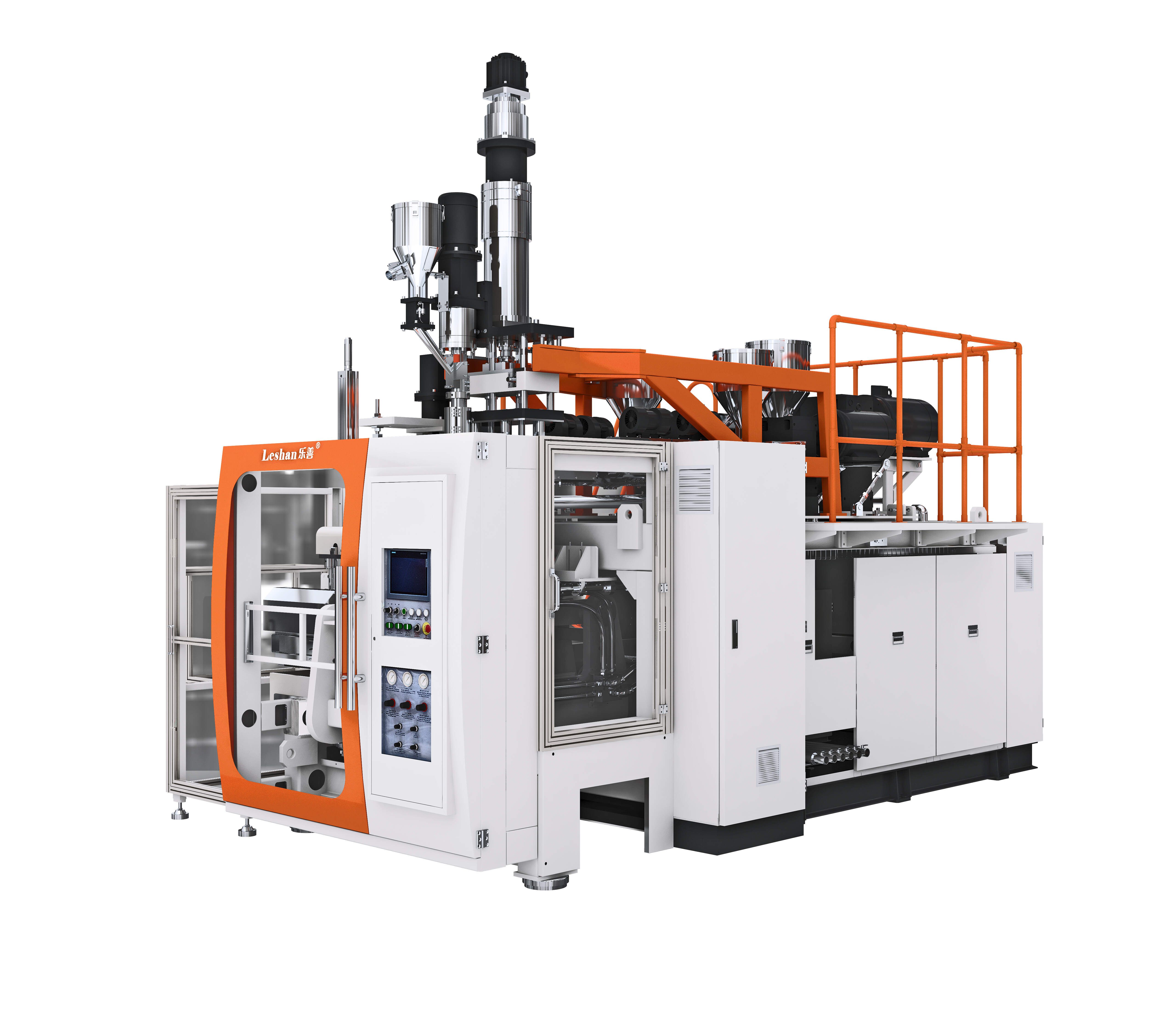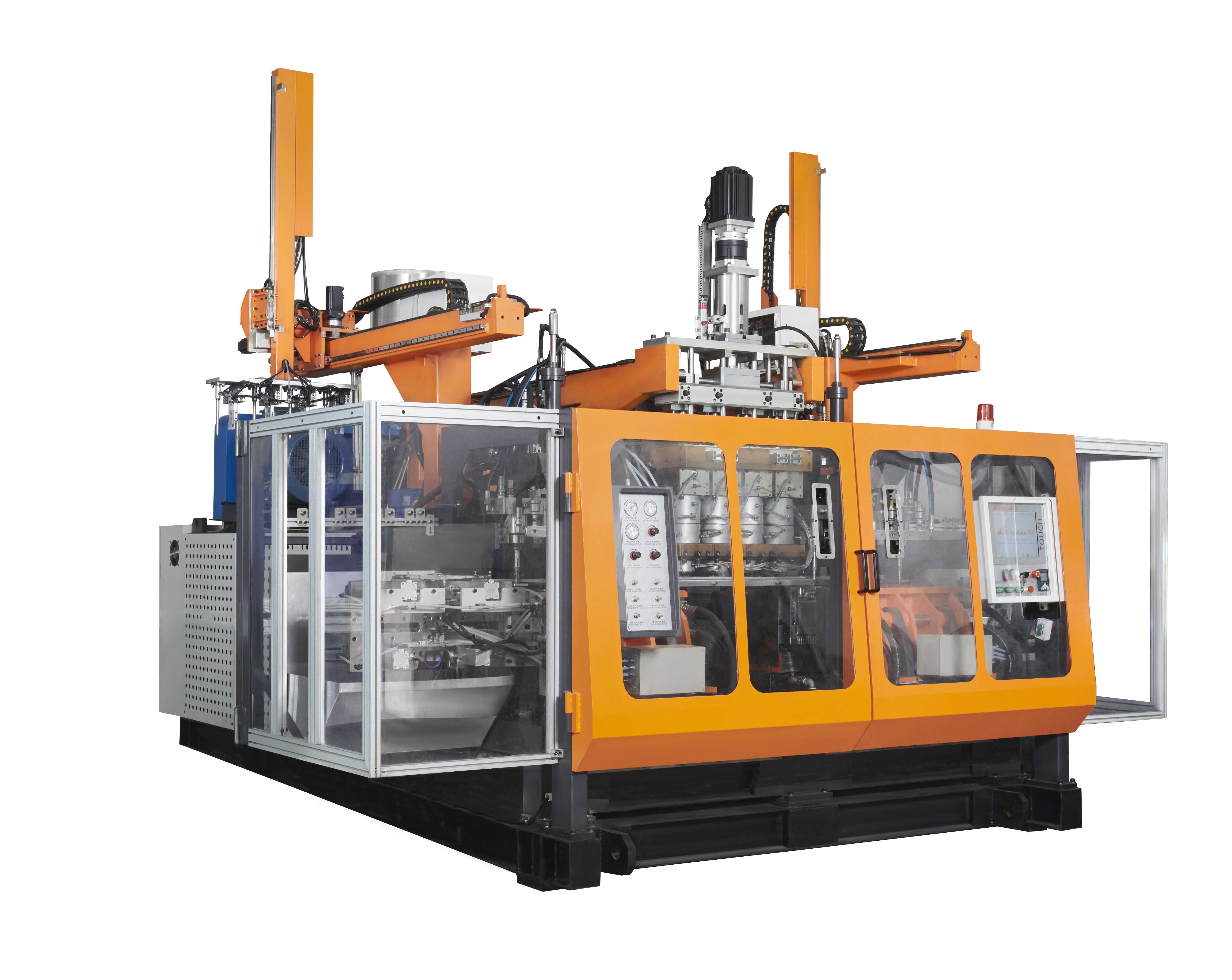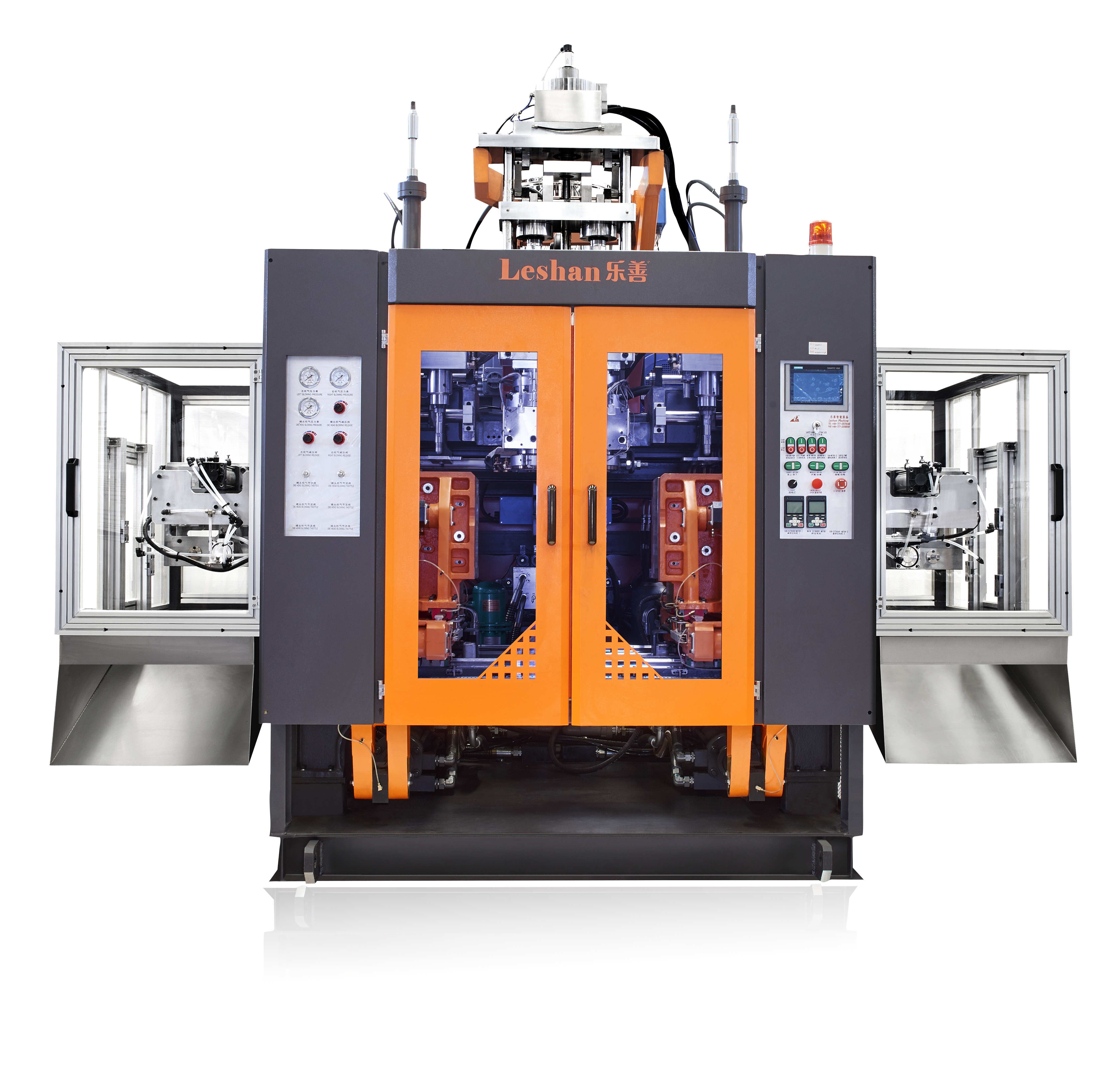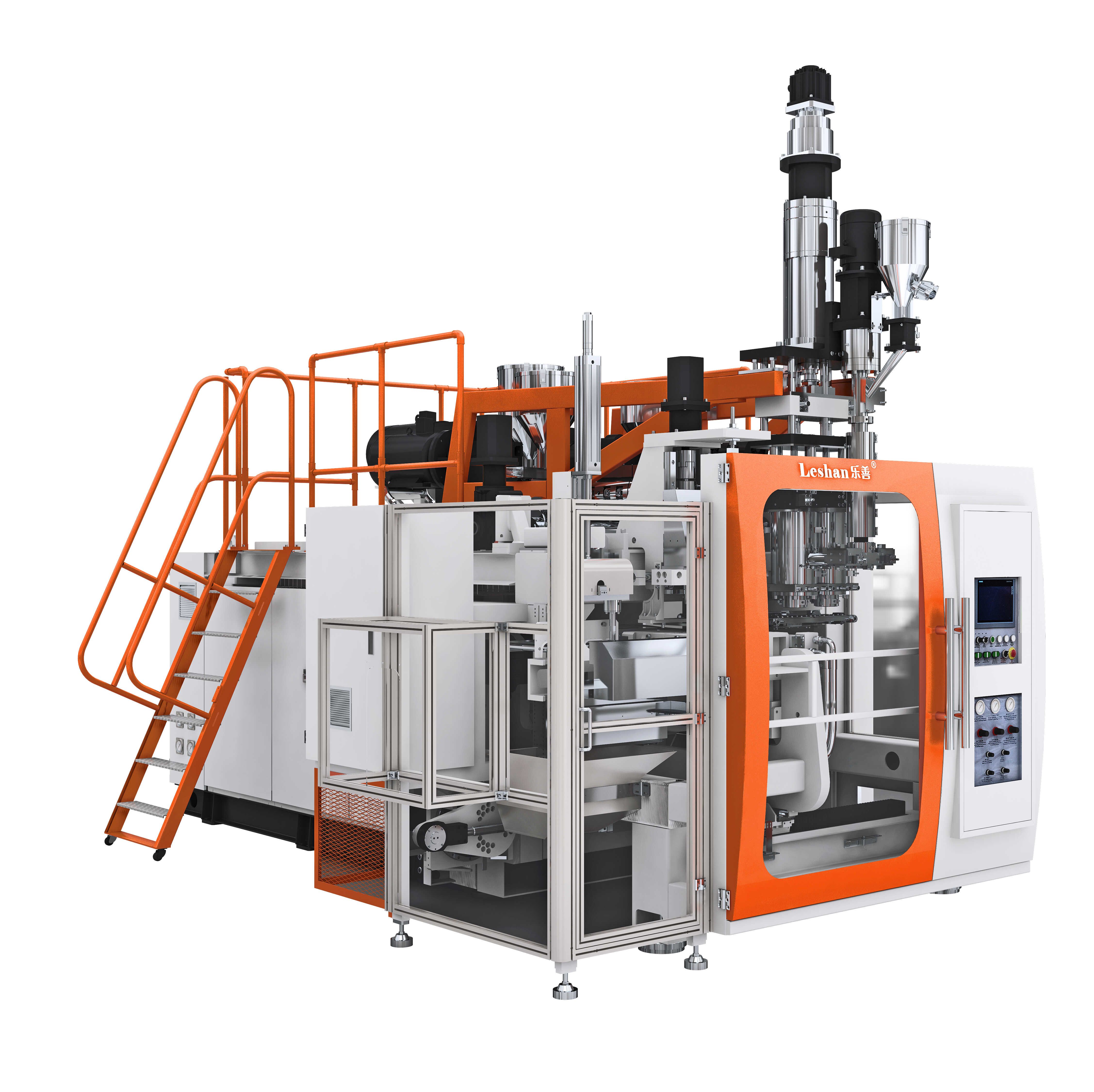
Accumulator Head Extrusion Blow Molder
Accumulator Head Extrusion Blow Molder
Leshan Intelligent Equipment Corp.,Ltd is an enterprise that produces Engine oil bottle blow molding machine,PET Machine,Auxiliary machine,Cleaning bottle blow molding machine,Milk bottle blow molding machine,Irregular shape product blow molding machine,Extrusion Die Head,multi-layer coextrusion blow molding machine,Blowing Mould & Injection Mould,Food bottle blow molding machine and other equipment, with complete testing equipment and strong technical strength. Our products have a wide variety, excellent quality, reasonable prices, and are widely used in industries such as food and beverage packaging, plastic products, cosmetics, etc.We also use International standards and the ISO9001:2012 quality management system in producing.
LESHAN has Numerically controlled lathe,Pentahedron gantry machining center,Numerical-controlled cutting machine,Vertical CNC gantry machining-center and other specialized equipment. Our machines have been exported to countries such as Russia, Australia, Poland, Saudi Arabia, and Congo, Republic of the,Bahrain,Marshall Islands. And it has gained widespread recognition and trust from users, able to meet constantly changing economic and social needs.
| Parameter | Information |
| Product Name | accumulator head extrusion blow molder |
| Place of Origin | China |
| Brand Name | Leshan |
| Condition | New |
| Video outgoing-inspection | Provided |
| Machinery Test Report | Provided |
| Warranty of core components | 1 year |
| Warranty | 1year |
| Port | ShunDe/GuangZhou/ShenZhen China |
| Application | Bottle |
| Core Components | PLC,Engine,Bearing,Motor,Gear,Pressure vessel...etc |
| Color | customized |
| Plastic Processed | PE,ABS,PA,HDPE,Polystyrene,PVC,PP...etc |
| Certification | CE,ISO9001:2012... |
| PLC Brand | Siemens |
| Packaging Details | Standard exporting machine packing with plastic film |
| Service | Online support |
| Automation | Automation |
| Supply Ability | 500 Set/Sets per year |
| Lead time (days) | 70 (To be negotiated) |
Please note: The above table data is for reference only. For specific information, please contact us.

accumulator head extrusion blow molder is suitable for processing a variety of plastics, such as polyethylene, polypropylene, polyvinyl chloride, etc. These plastics can be made into various shapes of containers through different processing methods, such as bottles, barrels, boxes, etc. The blow molding machine can also realize products of different thicknesses by adjusting the design and structure of the mold, thereby adapting the products to different needs.

accumulator head extrusion blow molder---FAQs Guide
2.What is the difference between traditional accumulator head extrusion blow molder and fully computer-controlled blow molding machines?
3.What types of blow molding machines are there?
4.What is a blow molding machine?
5.Is there a limit to the size range of accumulator head extrusion blow molder?
6.How to control the energy consumption of accumulator head extrusion blow molder?
7.How to choose a accumulator head extrusion blow molder that suits your own craft?
8.How does the extrusion blow molding process differ from injection blow molding, and what types of products are typically produced using each method?
9.What is the noise level of the accumulator head extrusion blow molder?
10.What waste materials will be generated during the production process of accumulator head extrusion blow molder?
11.How to choose the mold head of a accumulator head extrusion blow molder?
12.What is the operating cost of a accumulator head extrusion blow molder?
1.How to solve the malfunction of the accumulator head extrusion blow molder?
As one of the top accumulator head extrusion blow molder manufacturers in China, we take this very seriously.
1. Check the power supply: Make sure the machine is properly connected to a stable power source. If there is a power surge or fluctuation, it can cause the machine to malfunction.
2. Inspect the air supply: The blow molding machine requires a steady supply of compressed air to function properly. Check the air compressor and make sure it is providing enough pressure and volume.
3. Check the temperature settings: The temperature of the machine's heating elements must be set correctly for the plastic to melt and form properly. Make sure the temperature settings are appropriate for the type of plastic being used.
4. Clean and lubricate the machine: Over time, dust, debris, and residue can build up on the machine, causing it to malfunction. Clean and lubricate all moving parts to ensure smooth operation.
5. Check for worn or damaged parts: Inspect all parts of the machine for wear and tear. Replace any damaged or worn parts to prevent further malfunctions.
6. Adjust the mold: If the product being produced is not forming correctly, the mold may need to be adjusted. Make sure the mold is properly aligned and tightened.
7. Consult the manual: If the above steps do not solve the problem, consult the machine's manual for troubleshooting tips and solutions specific to your machine.
8. Call a professional: If the problem persists, it may be best to call a professional technician to diagnose and repair the machine. Attempting to fix complex issues without proper knowledge and training can cause further damage.
2.What is the difference between traditional accumulator head extrusion blow molder and fully computer-controlled blow molding machines?
We have the leading technology and innovation capabilities, and attach importance to employee training and development, and provide promotion opportunities.
Traditional blow molding machines are operated manually by a person, while fully computer-controlled blow molding machines are operated by a computer program. This means that traditional blow molding machines require more human labor and supervision, while fully computer-controlled machines can run automatically with minimal human intervention.
Additionally, traditional blow molding machines may have limited capabilities and may only be able to produce simple shapes, while fully computer-controlled machines can produce more complex and precise shapes. This is because the computer program can control the machine's movements and parameters with greater accuracy and consistency.
Furthermore, fully computer-controlled blow molding machines often have advanced features such as real-time monitoring, data collection, and automatic adjustments, which can improve efficiency and quality control.
Overall, the main difference between traditional blow molding machines and fully computer-controlled machines is the level of automation and precision in the production process.
3.What types of blow molding machines are there?
We should have a stable supply chain and logistics capabilities, and provide customers with high -quality, low -priced accumulator head extrusion blow molder products.
1. Extrusion blow molding machine: This type of machine uses a continuous extrusion process to produce hollow plastic products, such as bottles, containers, and tanks.
2. Injection blow molding machine: This machine combines the processes of injection molding and blow molding to produce small, complex, and precise plastic products, such as medical devices and electronic components.
3. Stretch blow molding machine: This machine uses a two-stage process to produce high-quality, lightweight bottles and containers from PET (polyethylene terephthalate) material.
4. Reheat stretch blow molding machine: This type of machine is similar to the stretch blow molding machine, but it uses preforms (partially formed bottles) instead of raw material to produce bottles and containers.
5. Rotational blow molding machine: This machine uses a rotating mold to produce large, hollow plastic products, such as tanks, drums, and toys.
6. Shuttle blow molding machine: This machine has a shuttle system that moves the mold back and forth, allowing for the production of larger and more complex products.
7. Injection stretch blow molding machine: This machine combines the processes of injection molding and stretch blow molding to produce high-quality, lightweight bottles and containers from PET material.
8. Accumulator blow molding machine: This machine uses an accumulator to store molten plastic, which is then used to produce large and complex products, such as automotive parts and industrial containers.
9. Continuous extrusion blow molding machine: This machine uses a continuous extrusion process to produce long, tubular plastic products, such as pipes and tubes.
10. Co-extrusion blow molding machine: This machine uses multiple extruders to produce products with multiple layers, allowing for the production of complex and multi-functional products.
4.What is a blow molding machine?
We maintain a stable growth through reasonable capital operations, focus on industry development trends and cutting -edge technologies, and focus on product quality and safety performance.
A blow molding machine is a manufacturing machine used to produce hollow plastic parts or containers by inflating a heated plastic tube or parison inside a mold until it takes the shape of the mold cavity. The process involves melting plastic resin and extruding it into a hollow tube, which is then clamped into a mold and inflated with compressed air until it conforms to the shape of the mold.
This process is commonly used to produce bottles, containers, and other hollow plastic products. Blow molding machines can be either extrusion blow molding machines or injection blow molding machines, depending on the method used to create the parison.

5.Is there a limit to the size range of accumulator head extrusion blow molder?
We continue to invest in research and development and continue to launch innovative products.
Yes, there is a limit to the size range of blow molding machines. The size range of blow molding machines is typically determined by the maximum volume of the mold cavity and the maximum clamping force of the machine. The maximum volume of the mold cavity can range from a few milliliters to several liters, while the maximum clamping force can range from a few tons to several hundred tons.
Therefore, the size range of blow molding machines can vary greatly depending on the specific machine and its capabilities. Generally, blow molding machines are used to produce plastic products ranging from small bottles and containers to larger items such as automotive parts and large industrial containers.
6.How to control the energy consumption of accumulator head extrusion blow molder?
We are a professional accumulator head extrusion blow molder company dedicated to providing high quality products and services.
1. Use energy-efficient machines: When purchasing blow molding machines, opt for models that are energy-efficient and have a high energy star rating. These machines are designed to consume less energy while still maintaining high production efficiency.
2. Regular maintenance: Regular maintenance of the machines is crucial in controlling energy consumption. This includes cleaning and lubricating the machines, checking for leaks, and replacing worn-out parts. A well-maintained machine will operate more efficiently and consume less energy.
3. Optimize production processes: Analyze the production processes and identify areas where energy consumption can be reduced. For example, reducing the amount of air pressure used in the blowing process can significantly reduce energy consumption.
4. Use energy-saving features: Many blow molding machines come with energy-saving features such as automatic shut-off, idle mode, and variable speed drives. These features can help reduce energy consumption when the machine is not in use or operating at a lower speed.
5. Monitor energy usage: Install energy meters to monitor the energy consumption of the machines. This will help identify areas where energy is being wasted and allow for adjustments to be made to reduce consumption.
6. Use energy-efficient materials: The type of material used in the blow molding process can also affect energy consumption. Opt for materials that require less energy to heat and mold, such as lightweight plastics.
7. Implement energy management systems: Consider implementing an energy management system that can track and analyze energy usage in real-time. This will help identify patterns and areas for improvement.
8. Train employees: Proper training of employees on the operation and maintenance of the machines can help reduce energy consumption. They should be aware of energy-saving practices and encouraged to follow them.
9. Turn off machines when not in use: Make it a practice to turn off the machines when they are not in use, such as during breaks or at the end of the day. This will help save energy and reduce unnecessary wear and tear on the machines.
10. Regularly review and update energy-saving strategies: Regularly review and update your energy-saving strategies to ensure they are still effective. As technology advances, new energy-saving techniques may become available, so it is essential to stay informed and make necessary changes.
7.How to choose a accumulator head extrusion blow molder that suits your own craft?
We continue to improve accumulator head extrusion blow molder products and processes to improve efficiency.
1. Determine the type of blow molding process: There are three main types of blow molding processes - extrusion blow molding, injection blow molding, and stretch blow molding. Each process has its own advantages and is suitable for different types of products. Determine which process is most suitable for your product before choosing a machine.
2. Consider the size and shape of your product: Blow molding machines come in different sizes and have different capabilities. Consider the size and shape of your product to determine the size and type of machine you need. For example, if you are producing large containers, you will need a machine with a larger clamping force and a larger mold size.
3. Look for a reputable manufacturer: It is important to choose a reputable manufacturer when buying a blow molding machine. Look for manufacturers with a good track record and positive reviews from other customers. This will ensure that you get a high-quality machine that is reliable and durable.
4. Check the machine's features and capabilities: Different blow molding machines come with different features and capabilities. Some machines may have advanced features such as multi-layer co-extrusion, while others may have simpler features. Consider the features that are important for your production process and choose a machine that meets your requirements.
5. Consider the production volume: The production volume of your product will also play a role in choosing the right blow molding machine. If you have a high production volume, you will need a machine with a higher output and faster cycle times. On the other hand, if you have a lower production volume, a smaller machine with a lower output may be more suitable.
6. Look for after-sales support: It is important to choose a manufacturer that offers good after-sales support. This includes technical support, spare parts availability, and maintenance services. A good after-sales support system will ensure that your machine runs smoothly and any issues are resolved quickly.
7. Consider your budget: Blow molding machines can be a significant investment, so it is important to consider your budget when choosing a machine. However, it is also important to keep in mind that a cheaper machine may not always be the best option in terms of quality and performance. Consider the long-term benefits and ROI when making your decision.
8. Test the machine: If possible, visit the manufacturer's facility and test the machine before making a purchase. This will give you a better understanding of the machine's capabilities and help you make an informed decision.
9. Seek expert advice: If you are new to blow molding, it is advisable to seek advice from experts in the industry. They can provide valuable insights and help you choose a machine that is suitable for your specific needs.
10. Consider future growth: It is important to consider your future growth plans when choosing a blow molding machine. Choose a machine that can accommodate your future production needs and can be upgraded if necessary. This will save you from having to invest in a new machine in the future.
8.How does the extrusion blow molding process differ from injection blow molding, and what types of products are typically produced using each method?
We have been working hard to improve service quality and meet customer needs.
Extrusion blow molding and injection blow molding are two different processes used to manufacture plastic products. While both methods involve melting plastic and shaping it into a desired form, there are some key differences between the two.
Extrusion blow molding is a process in which a molten tube of plastic, called a parison, is extruded through a die and then inflated to form a hollow product. The parison is then cooled and the mold opens to release the finished product. This process is commonly used to produce bottles, containers, and other hollow objects.
On the other hand, injection blow molding involves injecting molten plastic into a mold cavity, where it is then cooled and solidified. The mold then opens to release the finished product. This process is commonly used to produce small, complex, and precise products such as medical devices, pharmaceutical packaging, and small bottles.
One of the main differences between the two processes is the way the plastic is shaped. In extrusion blow molding, the plastic is shaped by the inflation of the parison, while in injection blow molding, the plastic is shaped by the mold cavity.
Another difference is the type of molds used. In extrusion blow molding, the molds are typically made of two halves that come together to form the desired shape. In injection blow molding, the molds are usually made of a single piece that is opened and closed to release the product.
The type of plastic used also differs between the two processes. Extrusion blow molding is typically used for high-density polyethylene (HDPE) and polyethylene terephthalate (PET) plastics, while injection blow molding is commonly used for polypropylene (PP) and polyethylene (PE) plastics.
In terms of product applications, extrusion blow molding is commonly used for larger, more simple products such as bottles and containers, while injection blow molding is used for smaller, more complex products such as medical devices and pharmaceutical packaging.
In summary, extrusion blow molding and injection blow molding are two different processes used to manufacture plastic products. While both methods involve melting plastic and shaping it into a desired form, they differ in the way the plastic is shaped, the type of molds used, and the types of products produced.

9.What is the noise level of the accumulator head extrusion blow molder?
accumulator head extrusion blow molder is not a product only, but also can help you comes to money-making.
The noise level of a blow molding machine can vary depending on the specific machine and its operating conditions. However, on average, blow molding machines can produce noise levels between 80-100 decibels (dB). This is considered to be a high level of noise and can potentially cause hearing damage if proper precautions are not taken. It is important for operators and workers to wear appropriate hearing protection when working with blow molding machines.
10.What waste materials will be generated during the production process of accumulator head extrusion blow molder?
Our company has many years of accumulator head extrusion blow molder experience and expertise.
1. Plastic waste: Blow molding machines use plastic materials such as polyethylene (PE), polypropylene (PP), and polyethylene terephthalate (PET) to produce plastic products. These materials are often left as waste after the production process.
2. Scrap plastic: During the production process, there may be excess or defective plastic parts that are not suitable for use. These scraps are considered waste and need to be properly disposed of.
3. Residual materials: Some materials, such as colorants and additives, may be left over after the production process. These materials may also be considered waste and need to be disposed of properly.
4. Packaging waste: Blow molding machines often require packaging materials such as cardboard boxes, plastic bags, and bubble wrap for shipping and storage. These materials can generate waste during the production process.
5. Cleaning waste: Blow molding machines need to be cleaned regularly to maintain their efficiency. This process can generate waste such as cleaning agents, rags, and other materials.
6. Energy waste: The production process of blow molding machines requires energy, which can result in waste in the form of emissions and by-products.
7. Water waste: Some blow molding machines use water for cooling or lubrication purposes. This water may become contaminated during the production process and need to be properly treated before disposal.
8. Metal waste: Some blow molding machines may use metal components, such as molds and machine parts, which can generate metal waste during the production process.
9. Hazardous waste: Some materials used in blow molding machines, such as solvents and chemicals, may be hazardous and require special handling and disposal methods.
10. Electronic waste: Blow molding machines may also contain electronic components that can become obsolete or damaged during the production process, resulting in electronic waste.
11.How to choose the mold head of a accumulator head extrusion blow molder?
We pay attention to the introduction and training of talents, scientifically regulate the management system, and focus on cultural construction and team cohesion.
1. Determine the type of blow molding machine: The first step in choosing the mold head is to determine the type of blow molding machine you have. There are three main types of blow molding machines: extrusion blow molding, injection blow molding, and stretch blow molding. Each type requires a different type of mold head.
2. Consider the material: The material you will be using for your product is also an important factor in choosing the mold head. Different materials have different properties and require different mold heads. For example, if you are using a high-density polyethylene (HDPE) material, you will need a mold head with a larger opening to accommodate the material's higher melt flow rate.
3. Determine the shape and size of the product: The shape and size of the product you want to produce will also play a role in choosing the mold head. The mold head needs to be able to create the desired shape and size of the product. If you are producing a complex shape, you may need a mold head with multiple cavities or a custom-made mold head.
4. Consider the production volume: The production volume also needs to be taken into account when choosing the mold head. If you are producing a large volume of products, you may need a mold head with multiple cavities to increase production efficiency.
5. Check the compatibility with the machine: It is important to ensure that the mold head you choose is compatible with your blow molding machine. The mold head needs to fit securely and work seamlessly with the machine to produce high-quality products.
6. Look for quality and durability: The mold head is a crucial component of the blow molding process, and it is important to choose one that is of high quality and durable. Look for mold heads made from high-quality materials and with a good track record of performance.
7. Consider the cost: The cost of the mold head is also an important factor to consider. While it is important to choose a high-quality and durable mold head, it is also important to stay within your budget. Compare prices from different suppliers and choose one that offers a good balance of quality and cost.
8. Consult with experts: If you are unsure about which mold head to choose, it is always a good idea to consult with experts in the field. They can provide valuable insights and recommendations based on your specific needs and requirements.
12.What is the operating cost of a accumulator head extrusion blow molder?
We attach importance to the innovation ability and team spirit of employees, have advanced R & D facilities and laboratories, and have a good quality management system.
The operating cost of a blow molding machine can vary depending on factors such as the size and type of machine, the materials being used, and the production volume. However, some common operating costs include:
1. Energy costs: Blow molding machines require a significant amount of energy to operate, including electricity for heating and cooling processes. The cost of energy can vary depending on the location and the efficiency of the machine.
2. Labor costs: The cost of labor includes the wages of operators and technicians who run the machine, as well as any maintenance or repair personnel.
3. Material costs: The cost of materials, such as plastic resins, can vary depending on the type and quality of the material being used.
4. Maintenance and repair costs: Regular maintenance and occasional repairs are necessary to keep the machine running smoothly, and these costs should be factored into the overall operating cost.
5. Overhead costs: This includes expenses such as rent, insurance, and administrative costs that are necessary for the operation of the machine.
Overall, the operating cost of a blow molding machine can range from a few hundred dollars per day for a small machine to thousands of dollars per day for a large, high-volume machine.

Tags: bench top extrusion blow molder machine,pipe blow molding machine,multiple layer blow molding machine,pc bottle blow molding machine,wheel blow molding machine
